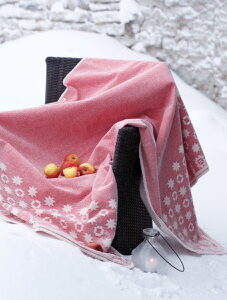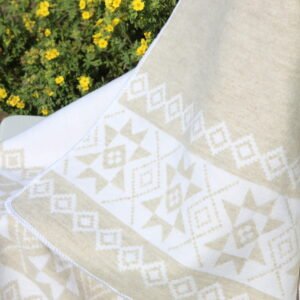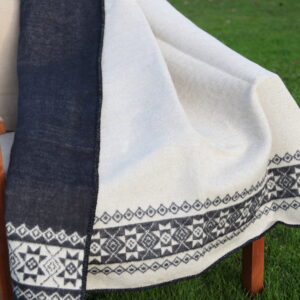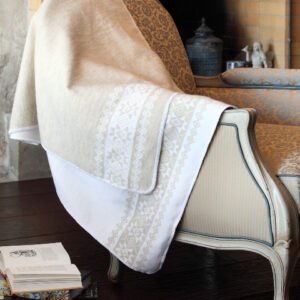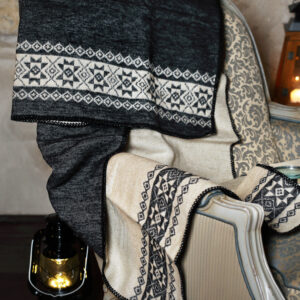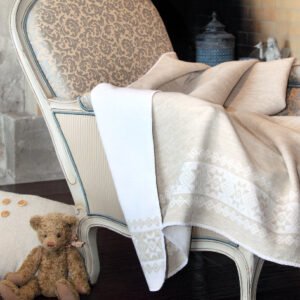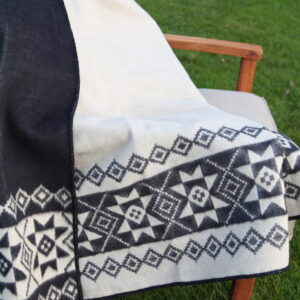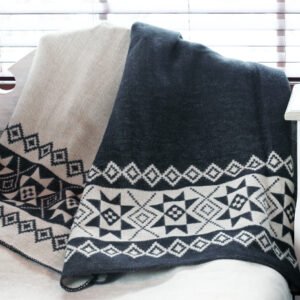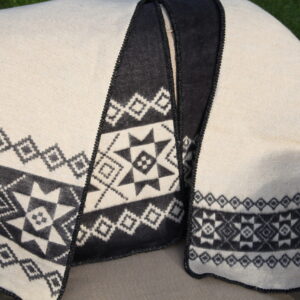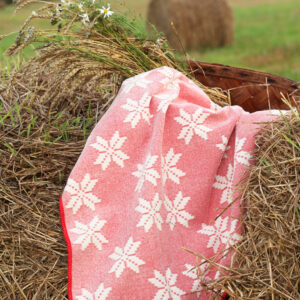+ Näita rohkem
-
Dimensions 70 x 200 cm 100% cotton In South Estonia, festive woollen rectangle wrap, worn across one’s shoulders, was the most respectable garment. The most common element of Setu patterns - square - is usually shaped into bigger ornaments. Also, cross-figure is often used as a pattern or as a background. Square developed from a circle that is a symbol of infinity, perfection and universe; it is a symbol of balance - relationship between the heaven and the earth. From the few elements mentioned above and few techniques used a lot of different patterns were derived, showing the talent and creativity of the people. Despite the fact that red occurred the most in other areas as well, Setu embroidery has a lot in common with the Eastern neighbors. However, the motifs are totally different. Red symbolized earth, love, fire, blood and emotionality. Setumaa scarf has the motifs of back-cloth.
-
Dimensions 145 x 200 cm 70% cotton, 30% flax In South Estonia the embroidery was rather modest. Using yarns of different colours, white, brown, red, green, blue i.e. became more common. Colourful stripes woven in the fabric and combinations of stitches were the main ways to decorate the shawls. South Estonian shawl has been inspired by the pattern of the Tartu folk costume shirt. Tartu shawl has been decorated with an eight-branch star that is surrounded with zigzag line consisting of squares.
-
Dimensions 70 x 180 cm 70% cotton, 30% flax In South Estonia the embroidery was rather modest. Using yarns of different colours, white, brown, red, green, blue i.e. became more common. Colourful stripes woven in the fabric and combinations of stitches were the main ways to decorate the shawls. South Estonian shawl has been inspired by the pattern of the Tartu folk costume shirt. Tartu shawl has been decorated with an eight-branch star that is surrounded with zigzag line consisting of squares.
-
Dimensions 70 x 180 cm 70% cotton, 30% flax In South Estonia the embroidery was rather modest. Using yarns of different colours, white, brown, red, green, blue i.e. became more common. Colourful stripes woven in the fabric and combinations of stitches were the main ways to decorate the shawls. South Estonian shawl has been inspired by the pattern of the Tartu folk costume shirt. Tartu shawl has been decorated with an eight-branch star that is surrounded with zigzag line consisting of squares.
-
Dimensions 110 x 180 cm 70% cotton, 30% flax In South Estonia the embroidery was rather modest. Using yarns of different colours, white, brown, red, green, blue i.e. became more common. Colourful stripes woven in the fabric and combinations of stitches were the main ways to decorate the shawls. South Estonian shawl has been inspired by the pattern of the Tartu folk costume shirt. Tartu shawl has been decorated with an eight-branch star that is surrounded with zigzag line consisting of squares.
-
Dimensions 110 x 180 cm 70% cotton, 30% flax In South Estonia the embroidery was rather modest. Using yarns of different colours, white, brown, red, green, blue i.e. became more common. Colourful stripes woven in the fabric and combinations of stitches were the main ways to decorate the shawls. South Estonian shawl has been inspired by the pattern of the Tartu folk costume shirt. Tartu shawl has been decorated with an eight-branch star that is surrounded with zigzag line consisting of squares.
-
Dimensions 70 x 180 cm 70% cotton, 30% flax In South Estonia the embroidery was rather modest. Using yarns of different colours, white, brown, red, green, blue i.e. became more common. Colourful stripes woven in the fabric and combinations of stitches were the main ways to decorate the shawls. South Estonian shawl has been inspired by the pattern of the Tartu folk costume shirt. Tartu shawl has been decorated with an eight-branch star that is surrounded with zigzag line consisting of squares.
-
Dimensions 110 x 180 cm 70% cotton, 30% flax In South Estonia the embroidery was rather modest. Using yarns of different colours, white, brown, red, green, blue i.e. became more common. Colourful stripes woven in the fabric and combinations of stitches were the main ways to decorate the shawls. South Estonian shawl has been inspired by the pattern of the Tartu folk costume shirt. Tartu shawl has been decorated with an eight-branch star that is surrounded with zigzag line consisting of squares.
-
Dimensions 35 x 180 cm 70% cotton, 30% flax In South Estonia the embroidery was rather modest. Using yarns of different colours, white, brown, red, green, blue i.e. became more common. Colourful stripes woven in the fabric and combinations of stitches were the main ways to decorate the shawls. South Estonian shawl has been inspired by the pattern of the Tartu folk costume shirt. Tartu shawl has been decorated with an eight-branch star that is surrounded with zigzag line consisting of squares.
-
Dimensions 110 x 110 cm 70% cotton, 30% flax Characteristic of South Estonia, beginning from the end of the 18th century is geometric embroidery where white or red cotton yarn is used. Wrap had different names in South Estonia. It was woollen, worn across one’s shoulder or covering the head, if necessary. Only married women had the right to wear one. In the second half of the 19th century old oblong plaids started to be replaced by square shawls according to the urban fashion. In the beginning people bought them but later they started to make them at home or ordered them from weavers. The shawl - as an item to be bought - was regarded as a sign of prosperity. It was worn during cold and rainy weather, folded triangularly; during warmer weather - folded, on one’s arm. Wearing shawls was particularly common in Mulgimaa.


